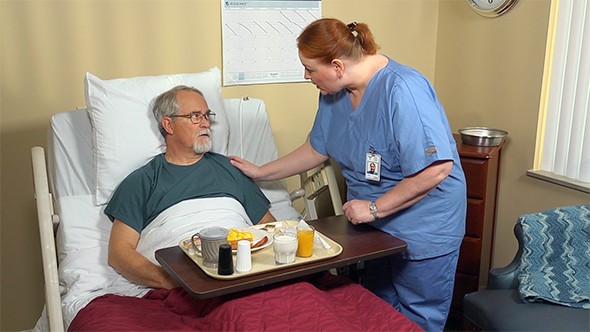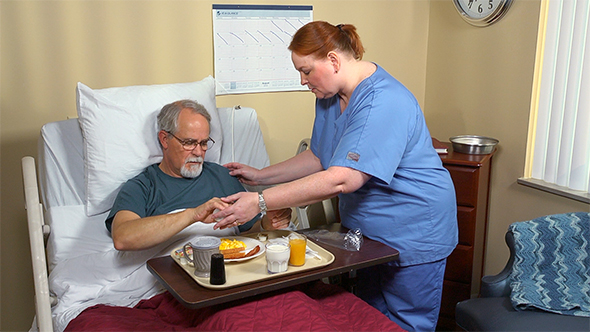Confusion and Dementia
Select a Skill:
- » Caring for the Person with Confusion and Dementia
- » Caring for the Person with AD and Other Dementias
Take the Review Test:

Purpose

- Confusion has many causes. Diseases, infections, hearing and vision loss, drug side effects, and brain injury are some causes.
- Acute confusion (delirium) occurs suddenly and is usually temporary. Causes include infection, illness, injury, drugs, and surgery. Treatment is aimed at the cause.
- Confusion from physical changes cannot be cured. Some measures help improve function. You must meet the person’s basic needs.
- Dementia is the loss of cognitive function that interferes with routine personal, social, and occupational activities. It is not a normal part of aging. Early warning signs include:
- Recent memory loss that affects job skills
- Problems with common tasks, such as dressing, cooking, and driving
- Problems with language, such as forgetting simple words
- Getting lost in familiar places
- Misplacing things and putting things in odd places
- Personality changes
- Poor or decreased judgment
- Loss of interest in life
- If brain changes have not occurred, some dementias can be reversed. Treatable causes include drugs, alcohol, delirium, depression, tumors, head injuries, infection, vision and hearing problems, and heart, lung, and blood vessel problems.
- Delirium and depression can be mistaken for dementia.
- Delirium is a state of sudden, severe confusion and rapid changes in brain function. Usually temporary and reversible, it occurs with physical or mental illness. It is an emergency.
- Depression is the most common mental health problem in older persons. It is often overlooked.
Equipment
Roll cursor over items to see labels. For the purposes of clearly depicting the equipment, a barrier is not shown in this photo. When providing care, a barrier should always be placed on the surface before placing the equipment.

Large calendar
Clock with large numbers
Eyeglasses
Hearing aids
Framed family photograph
Family photo album
Magazines
Radio/CD player
Standard nightlight
Sensor nightlight
Plastic cup with lid
Plastic eating utensils
Wheelchair
Delegation
- Follow delegation guidelines. Before caring for the person with confusion and dementia, obtain this information from the nurse and care plan:
- Specific types of care noted in the care plan
- What observations to report and record
- When to report observations
- What patient or resident concerns to report at once
Preparation

- Observe quality-of-life measures.
- Review the information under Delegation and Safety and Comfort.
- Practice hand hygiene.
- Collect the equipment.
- Identify the person. Check the ID bracelet against the assignment sheet. Also call the person by name.
- Focus on PRIDE:
- Personal and professional responsibility
- Rights and respect
- Independence and social interaction
- Delegation and teamwork
- Ethics and laws
Safety

- Always provide for safety.
- Because delirium is an emergency, observe for its signs and symptoms, including:
- Changes in alertness, sensation, and awareness
- Slow movement or inactivity
- Drowsiness
- Confusion about time or place
- Decreased memory
- Thinking and behavior that are without purpose
- Difficulty concentrating
- Speech that does not make sense
- Emotional changes, such as anger, anxiety, apathy, depression, euphoria, or irritability
- Incontinence
- Restlessness
Comfort
- Provide a calm, relaxed, and peaceful setting. Prevent loud noises, rushing, and congested hallways and dining rooms.
- Follow the person’s routine. Meals, bathing, exercise, TV, bedtime, and other activities have a schedule. This promotes a sense of order and what to expect.
Procedure Video
Audio Description: OFFFollow-up Care

- Provide for comfort.
- Place the call light within reach.
- Raise or lower bed rails. Follow the care plan.
- Complete a safety check of the room.
- Practice hand hygiene.
Reporting/Recording
- Report and record your observations, including any changes in the person’s condition.
Review Questions
Select the best answer.
1. Which term is used to describe acute confusion?
Select the best answer.
2. Which observation may be a sign or symptom of delirium?
Select the best answer.
3. Which action is appropriate for a person with confusion?
 Perform as many ADLs for the person as possible.
Perform as many ADLs for the person as possible. Rearrange the person’s belongings for easy access.
Rearrange the person’s belongings for easy access. Have the person wear regular clothes during the day.
Have the person wear regular clothes during the day. Break up the person’s usual routine to avoid boredom.
Break up the person’s usual routine to avoid boredom.
Select the best answer.
4. A person is confused after receiving a new drug. What is the likely cause of the confusion?
 Alzheimer’s disease
Alzheimer’s disease A traumatic brain injury
A traumatic brain injury A permanent change in the brain
A permanent change in the brain A temporary change in mental function
A temporary change in mental function
Select the best answer.
5. Care for a person with confusion and dementia should reflect the acronym PRIDE. What does the I stand for?
You have completed the Review Questions for this skill. To take the Review again select the Start Over button. To proceed to another skill select from the dropdown menu. Select the Home or Back button to proceed to the next section.

